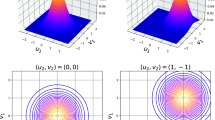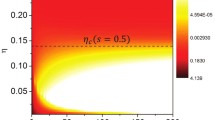Abstract
We derive explicitly the thermal state of the two-coupled harmonic oscillator system when the spring and coupling constants are arbitrarily time-dependent. In particular, we focus on the case of sudden change of frequencies. In this case we compute purity function, Rényi and von Neumann entropies, and mutual information analytically and examine their temperature dependence. We also discuss on the thermal entanglement phase transition by making use of the negativity-like quantity. Our calculation shows that the critical temperature \(T_c\) increases with increasing the difference between the initial and final frequencies. In this way we can protect the entanglement against the external temperature by introducing large difference of initial and final frequencies.





Similar content being viewed by others
Notes
In fact, one can show that \(b (\beta )\) in Eq. (2.17) is a solution of \(\frac{d^2 b}{d \beta ^2} -\omega ^2 b = - \frac{\omega _0^2}{b^3}\).
The subscript E in \(\Gamma _{E,j}\) stands for “Euclidean.” This subscript is attached to stress the point that the inverse temperature \(\beta \) is introduced as a Euclidean time.
References
Schrödinger, E.: Die gegenwärtige Situation in der Quantenmechanik. Naturwissenschaften 23, 807 (1935)
Nielsen, M.A., Chuang, I.L.: Quantum Computation and Quantum Information. Cambridge University Press, Cambridge, England (2000)
Horodecki, R., Horodecki, P., Horodecki, M., Horodecki, K.: Quantum Entanglement. Rev. Mod. Phys. 81, 865 (2009). arXiv:quant-ph/0702225 and references therein
Bennett, C.H., Brassard, G., Crepeau, C., Jozsa, R., Peres, A., Wootters, W.K.: Teleporting an unknown quantum state via dual classical and Einstein–Podolsky–Rosen channels. Phys. Rev. Lett. 70, 1895 (1993)
Bennett, C.H., Wiesner, S.J.: Communication via one- and two-particle operators on Einstein–Podolsky–Rosen states. Phys. Rev. Lett. 69, 2881 (1992)
Scarani, V., Lblisdir, S., Gisin, N., Acin, A.: Quantum cloning. Rev. Mod. Phys. 77, 1225 (2005). arXiv:quant-ph/0511088 and references therein
Ekert, A.K.: Quantum cryptography based on Bell’s theorem. Phys. Rev. Lett. 67, 661 (1991)
Kollmitzer, C., Pivk, M.: Applied Quantum Cryptography. Springer, Heidelberg (2010)
Wang, K., Wang, X., Zhan, X., Bian, Z., Li, J., Sanders, B.C., Xue, P.: Entanglement-enhanced quantum metrology in a noisy environment. Phys. Rev. A 97, 042112 (2018). arXiv:1707.08790
Vidal, G.: Efficient classical simulation of slightly entangled quantum computations. Phys. Rev. Lett. 91, 147902 (2003). arXiv:quant-ph/0301063
Ladd, T.D., Jelezko, F., Laflamme, R., Nakamura, Y., Monroe, C., O’Brien, J.L.: Quantum computers. Nature 464, 45 (2010). arXiv:1009.2267
Ghernaouti-Helie, S., Tashi, I., Laenger, T., Monyk, C.: SECOQC business white paper. arXiv:0904.4073
Zurek, W.H.: Decoherence, einselection, and the quantum origins of the classical. Rev. Mod. Phys. 75, 715 (2003). arXiv:quant-ph/0105127
Yu, T., Eberly, J.H.: Finite-time disentanglement via spontaneous emission. Phys. Rev. Lett. 93, 140404 (2004). arXiv:quant-ph/0404161
Yu, T., Eberly, J.H.: Sudden death of entanglement: classical noise effects. Opt. Commun. 264, 393 (2006). arXiv:quant-ph/0602196
Yu, T., Eberly, J.H.: Quantum open system theory: bipartite aspects. Phys. Rev. Lett. 97, 140403 (2006). arXiv:quant-ph/0603256
Yu, T., Eberly, J.H.: Sudden Death of Entanglement. Science 323, 598 (2009). arXiv:0910.1396
Almeida, M.P., et al.: Environment-induced sudden death of entanglement. Science 316, 579 (2007). arXiv:quant-ph/0701184
Park, D.K.: Tripartite entanglement dynamics in the presence of Markovian or non-Markovian environment. Quant. Inf. Proc. 15, 3189 (2016). arXiv:1601.00273
Park, D.K.: Thermal entanglement and thermal discord in two-qubit Heisenberg XYZ chain with Dzyaloshinskii–Moriya interactions. Quant. Inf. Process. 18, 172 (2019). arXiv:1901.06165
Hill, S., Wootters, W.K.: Entanglement of a Pair of quantum bits. Phys. Rev. Lett. 78, 5022 (1997). arXiv:quant-ph/9703041
Wootters, W.K.: Entanglement of formation of an arbitrary state of two qubits. Phys. Rev. Lett. 80, 2245 (1998). arXiv:quant-ph/9709029
Dzyaloshinsky, I.: A thermodynamic theory of weak ferromagnetism of antiferromagnetics. J. Phys. Chem. Solids 4, 241 (1958)
Moriya, T.: Anisotropic superexchange interaction and weak ferromagnetism. Phys. Rev. 120, 91 (1960)
Peres, A.: Separability criterion for density matrices. Phys. Rev. Lett. 77, 1413 (1996). arXiv:quant-ph/9604005
Horodecki, M., Horodecki, P., Horodecki, R.: Separability of mixed states: necessary and sufficient conditions. Phys. Lett. 223, 1 (1996). arXiv:quant-ph/9605038
Horodecki, P.: Separability criterion and inseparable mixed states with positive partial transposition. Phys. Lett. A 232, 333 (1997). arXiv:quant-ph/9703004
Duan, L.M., Giedke, G., Cirac, J.I., Zoller, P.: Inseparability criterion for continuous variable systems. Phys. Rev. Lett. 84, 2722 (2000). arXiv:quant-ph/9908056
Simon, R.: Peres–Horodecki separability criterion for continuous variable systems. Phys. Rev. Lett. 84, 2726 (2000). arXiv:quant-ph/9909044
Vida, G., Werner, R.F.: A computable measure of entanglement. Phys. Rev. A 65, 032314 (2002). arXiv:quant-ph/0102117
Feynman, R.P., Hibbs, A.R.: Quantum Mechanics and Path Integrals. McGraw-Hill, New York (1965)
Kleinert, H.: Path integrals in Quantum Mechanics, Statistics, and Polymer Physics. World Scientific, Singapore (1995)
Lewis Jr., H.R., Riesenfeld, W.B.: An exact quantum theory of the time-dependent harmonic oscillator and of a charged particle in a time-dependent electromagnetic field. J. Math. Phys. 10, 1458 (1969)
Lohe, M.A.: Exact time dependence of solutions to the time-dependent Schrödinger equation. J. Phys. A: Math. Theor. 42, 035307 (2009)
Pinney, E.: The nonlinear differential equation. Proc. Am. Math. Soc. 1, 681 (1950)
Prudnikov, A.P., Brychkov, Y.A., Marichev, O.I.: Integrals and Series. Gordon and Breach Science Publishers, New York (1983)
Abramowitz, M., Stegun, I.A.: Handbook of Mathematical Functions. Dover Publications, New York (1972)
Bennett, C.H., DiVincenzo, D.P., Smokin, J.A., Wootters, W.K.: Mixed-state entanglement and quantum error correction. Phys. Rev. A 54, 3824 (1996). arXiv:quant-ph/9604024
Uhlmann, A.: Fidelity and concurrence of conjugate states. Phys. Rev. A 62, 032307 (2000). arXiv:quant-ph/9909060
Duan, L.M., Giedke, G., Cirac, J.I., Zoller, P.: Entanglement purification of Gaussian variable quantum states. Phys. Rev. Lett. 84, 4002 (2000). arXiv:quant-ph/9912017
Giedke, G., Duan, L.M., Cirac, J.I., Zoller, P.: All inseparable two-mode Gaussian continuous variable states are distillable. arXiv:quant-ph/0007061
Cramer, M., Eisert, J., Plenio, M.B., Dreißig, J.: Entanglement-area law for general bosonic harmonic lattice systems. Phys. Rev. A 73, 012309 (2006). arXiv:quant-ph/0505092
Tserkis, S., Onoe, S., Ralph, T.C.: Quantifying entanglement of formation for two-mode Gaussian states: Analytical expressions for upper and lower bounds and numerical estimation of its exact value. Phys. Rev. A 99, 052337 (2019). arXiv:1903.09961
Author information
Authors and Affiliations
Corresponding author
Additional information
Publisher's Note
Springer Nature remains neutral with regard to jurisdictional claims in published maps and institutional affiliations.
Appendix A
Appendix A
In this section we examine the eigenvalue equation of the following bipartite Gaussian state:
where \(A = \sqrt{(a_1 + a_2 - 2c)^2 - (b_1 + b_2 + 2 f)^2} / \pi \). If \(a_1 = \alpha _1\), \(a_2 = \alpha _2\), \(b_1 = \alpha _3\), \(b_2=\alpha _4\), \(c = \alpha _5\), and \(f = \alpha _6\), \(\rho _2\) is exactly the same with the thermal state \(\rho _T\) given in Eq. (3.12). Now let us consider the eigenvalue equation
First we change the variables as
Then Eq. (A.2) is simplified as
Now, we define
Then, Eq. (A.4) is solved if one solves the following two single-party eigenvalue equations:
The eigenvalue of Eq. (A.2) can be computed as \(\lambda _{mn} = A p_m q_n\).
By making use of Eqs. (2.25) and (2.26) one can show \(\lambda _{mn} = (1 - \xi _1) \xi _1^m (1 - \xi _2) \xi _2^n\), where
with
We can also use Eqs. (2.25) and (2.26) to derive the normalized eigenfunction, whose explicit expression is
where
and the normalization constants \({\mathcal {C}}_{1,m}\) and \({\mathcal {C}}_{2,n}\) are
Thus, the spectral decomposition of \(\rho _2\) is
where \(\lambda _{mn}\) and \(f_{mn}\) are given in Eqs. (A.7) and (A.9), respectively.
Rights and permissions
About this article
Cite this article
Park, D. Thermal entanglement phase transition in coupled harmonic oscillators with arbitrary time-dependent frequencies. Quantum Inf Process 19, 129 (2020). https://doi.org/10.1007/s11128-020-02626-4
Received:
Accepted:
Published:
DOI: https://doi.org/10.1007/s11128-020-02626-4




